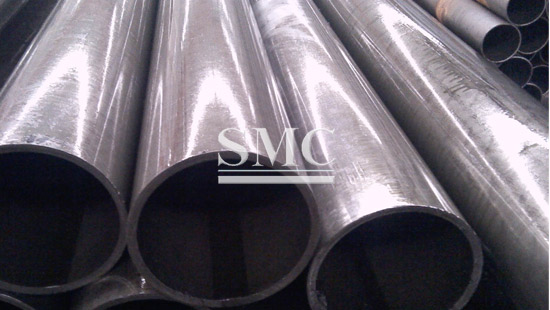Notice: Undefined index: sith_hide_share in /www/sites/alloy.wiki/index/wp-content/themes/likegoogle/single.php on line 32
Deprecated: get_settings is deprecated since version 2.1.0! Use get_option() instead. in /www/sites/alloy.wiki/index/wp-includes/functions.php on line 4862
A steel pipe made of a single piece of metal without seams on the surface is called a seamless steel pipe. According to the production method, seamless tubes are divided into hot rolled tubes, cold rolled tubes, cold drawn tubes, extruded tubes, and jacked tubes. According to the cross-sectional shape, seamless steel tubes are divided into two types: round and special. Special-shaped tubes have various complex shapes such as square, oval, triangle, hexagon, melon, star, and finned tube. The maximum diameter is 650mm and the minimum diameter is 0.3mm. Depending on the application, there are thick-walled pipes and thin-walled pipes. Seamless steel pipes are mainly used for petroleum geological drilling pipes, cracking pipes for petrochemical industry, boiler pipes, bearing pipes, and high-precision structural steel pipes for automobiles, tractors and aviation.
Classification
Jointless steel pipe along the perimeter of its cross section. According to different production methods, it is divided into hot-rolled pipe, cold-rolled pipe, cold-drawn pipe, extruded pipe, pipe jack, etc., all have their own process regulations. Materials are ordinary and high-quality carbon structural steel, low alloy steel, alloy steel, stainless acid-resistant steel, etc. According to the purpose, it is divided into two types: general purpose (for water transmission, gas pipelines and structural parts, mechanical parts) and special purpose (for boilers, geological exploration, bearings, acid resistance, etc.).

Use
1. Seamless steel tubes are widely used. General purpose seamless steel tubes are rolled from ordinary carbon structural steel, low-alloy structural steel or alloy structural steel with the largest output, and are mainly used as pipelines or structural parts for conveying fluids.
2. It is divided into three categories according to different uses:
a. Supply according to chemical composition and mechanical properties;
b. Supply according to mechanical properties;
c. Supply according to hydrostatic test.
For steel pipes supplied according to categories a and b, if they are used to withstand liquid pressure, hydraulic tests are also required.
3. Special-purpose seamless pipes include boiler seamless pipes, chemical and electric power, geological seamless steel pipes and petroleum seamless pipes.
Seamless steel pipe has a hollow section and is widely used as a pipeline for transporting fluids, such as pipelines for transporting oil, natural gas, gas, water and certain solid materials. Compared with solid steel such as round steel, steel pipe is lighter in weight when it has the same bending and torsional strength, and it is an economical section steel. Widely used in the manufacture of structural parts and mechanical parts, such as petroleum drill rods, automobile transmission shafts, bicycle frames, and steel scaffolding used in building construction. Man-hours have been widely used to manufacture steel pipes.
Production process
①Main production process of hot rolled seamless steel pipe:
Pipe billet preparation and inspection
② The main production process of cold rolled (drawn) seamless steel pipe:
Blank preparation → pickling and lubrication → cold rolling (drawing) → heat treatment → straightening → finishing → inspection
The production process of general seamless steel tubes can be divided into two types: cold drawing and hot rolling. The production process of cold rolled seamless steel tubes is generally more complicated than hot rolling. In the sizing test, if the surface does not respond to cracks, the round pipe is cut by a cutter and cut into a blank of about one meter in length. Then enter the annealing process. Annealing should be acid pickled with an acidic liquid. When pickling, pay attention to whether there is a large amount of blistering on the surface. If there is a large amount of blistering, the quality of the steel pipe does not reach the corresponding standard. The appearance of cold-rolled seamless steel pipe is shorter than that of hot-rolled seamless steel pipe. The thickness of cold-rolled seamless steel pipe is generally smaller than that of hot-rolled seamless steel pipe, but the surface looks brighter than that of thick-walled seamless steel pipe. It’s rough, and it doesn’t have too much burr.
The delivery state of hot-rolled seamless steel pipe is generally the hot-rolled state, which is delivered after heat treatment. Hot rolled seamless steel pipe is subject to strict manual selection by the staff after quality inspection, and the surface is oiled after quality inspection, followed by multiple cold drawing experiments, and perforation experiments after hot rolling treatment. If the diameter of the perforation is too large, straightening correction is required. After straightening, it is transferred to the flaw detector by the conveying device for flaw detection experiments. Finally, the labels are labeled and the specifications are arranged and placed in the warehouse.
Guest contributors are welcome at the Alloy Wiki.It is a weekly wiki and guide on alloy information and processing technology, while also about the vast array of opportunities that are present in manufacturing. Our team of writers consists of a Machining Material Supplier / Machinist / Tool and Die Maker, a Biomedical Engineer / Product Development Engineer, a Job Development Coordinator / Adjunct Professor, and a President and CEO of a manufacturing facility.
Link to this article:Characteristics of Seamless Steel Tubes
Reprint Statement: If there are no special instructions, all articles on this site are original. Please indicate the source for reprinting:Alloy Wiki,thanks!^^


